The Electro-cell
"Tesla Coil Charge Collector"
Online Instruction Manual
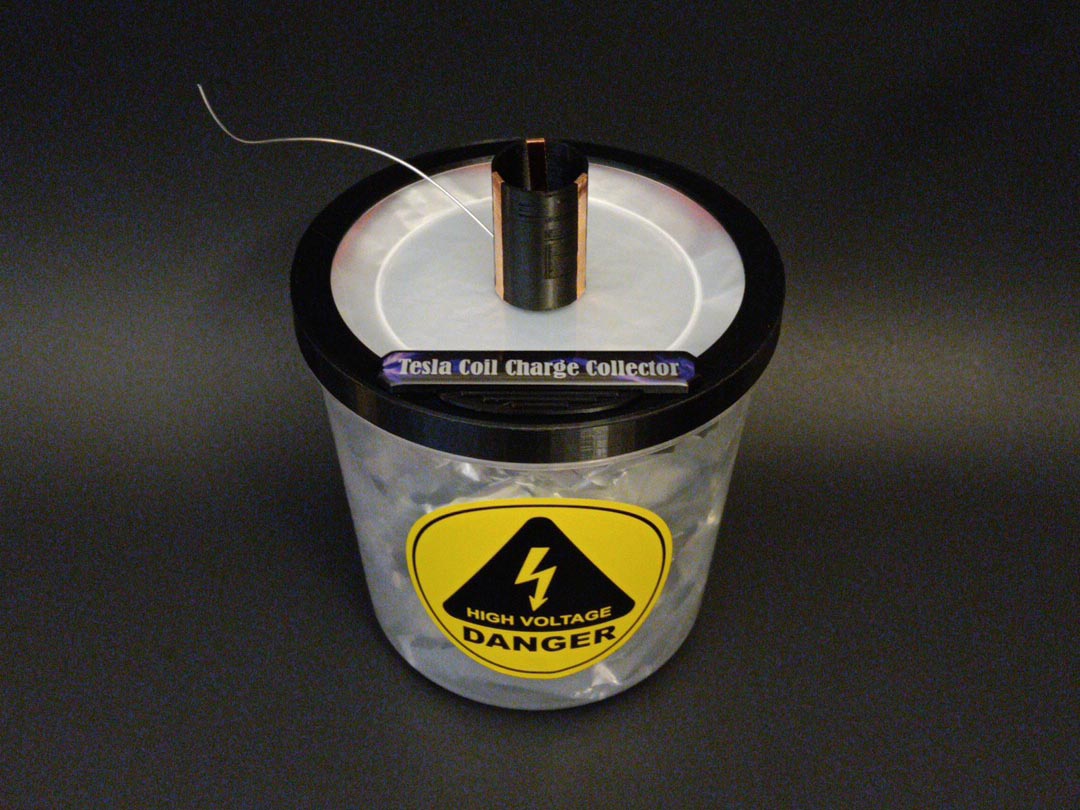
HARDWARE REQUIRED
A non-grounded, high-amperage WCSGTC (Water-cooled Spark Gap Tesla Coil) is required to properly charge an Electro-cell and power the included accessories.
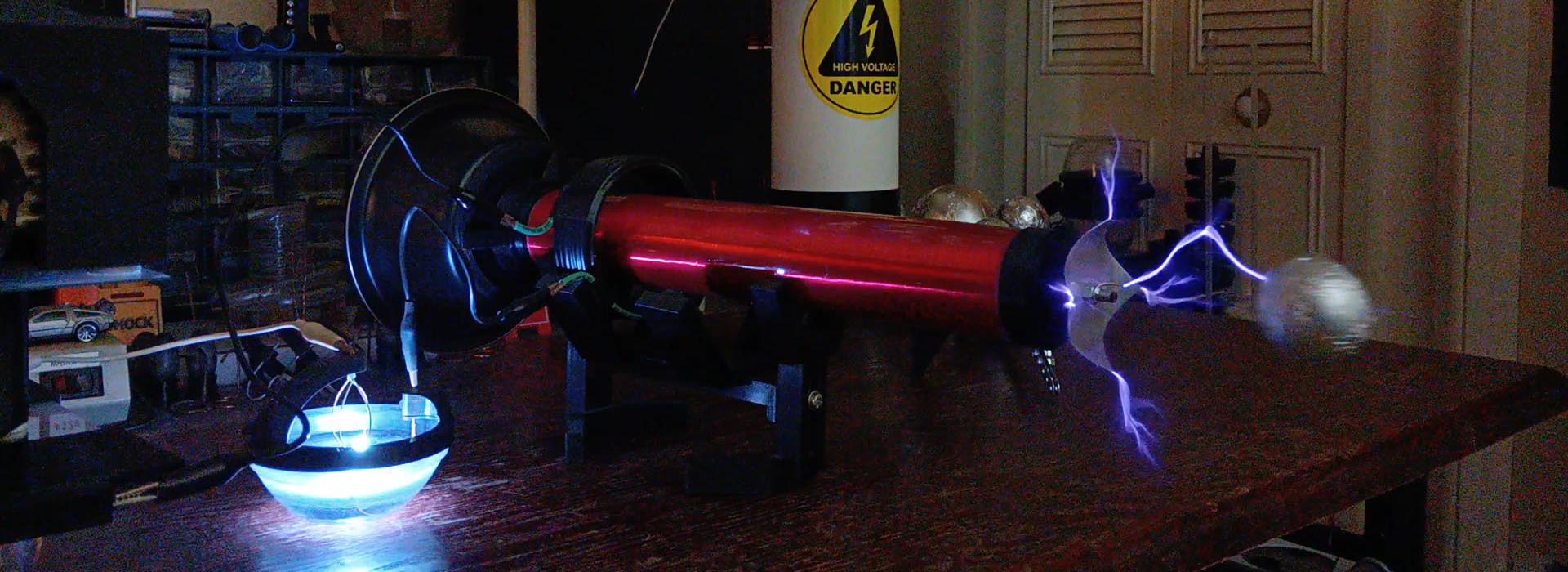

Please consult the following media or product manual which came with your WCSG / SGL for further information on their tesla coil setups and requirements.
How a Water-cooled Spark Gap Works:
Journal - https://www.wcsg-science.com/#howitworks
Video - https://www.youtube.com/watch?v=mjeaYCkkxnI
Product Manual - https://www.wcsg-science.com/mini.html
How a Spark Gap Lingam Works:
Journal - https://www.wcsg-science.com/how-it-works-sgl.html
Video - https://www.youtube.com/watch?v=91cjP0m-dtU
Product Manual - https://www.wcsg-science.com/sgl.html
SAFETY
NEVER TOUCH an Electro-cell while it is actively being powered! WCSG's are high-amperage spark gaps; anything attached to an active system is extremely dangerous and should be well respected.
To discharge your Electro-cell (with tesla coil off), simply touch the "Focal Array" or "Pull Tail" while holding a grounded or metal object.
You MAY TOUCH the Electro-cell after the tesla coil is TURNED OFF as it can only hold a set level of charge, however - if you do not discharge the Electro-cell first, the resulting zap is comparable to a wicked electrostatic shock (like you would get from touching a door knob) and can be at the most, very, very uncomfortable. (IT IS RECOMMENDED to safely take the "Tesla Coil Charge Collector Challenge" and touch a charged collector - after the system has been turned off - to get a feel for and also not be as suprised WHEN YOU DO inadvertently get a tiny zap from it).
Be certain the base and sides of the Electro-cell are clear of conductive materials before operation (such as metal rods, wire and screws on or underneath the table) or the high-amperage charges can concentrate to one spot, melting a hole through the shell.
GETTING STARTED ! !
The first thing to do before getting things set up is to understand all the separate parts of your Electro-cell and how they work together.
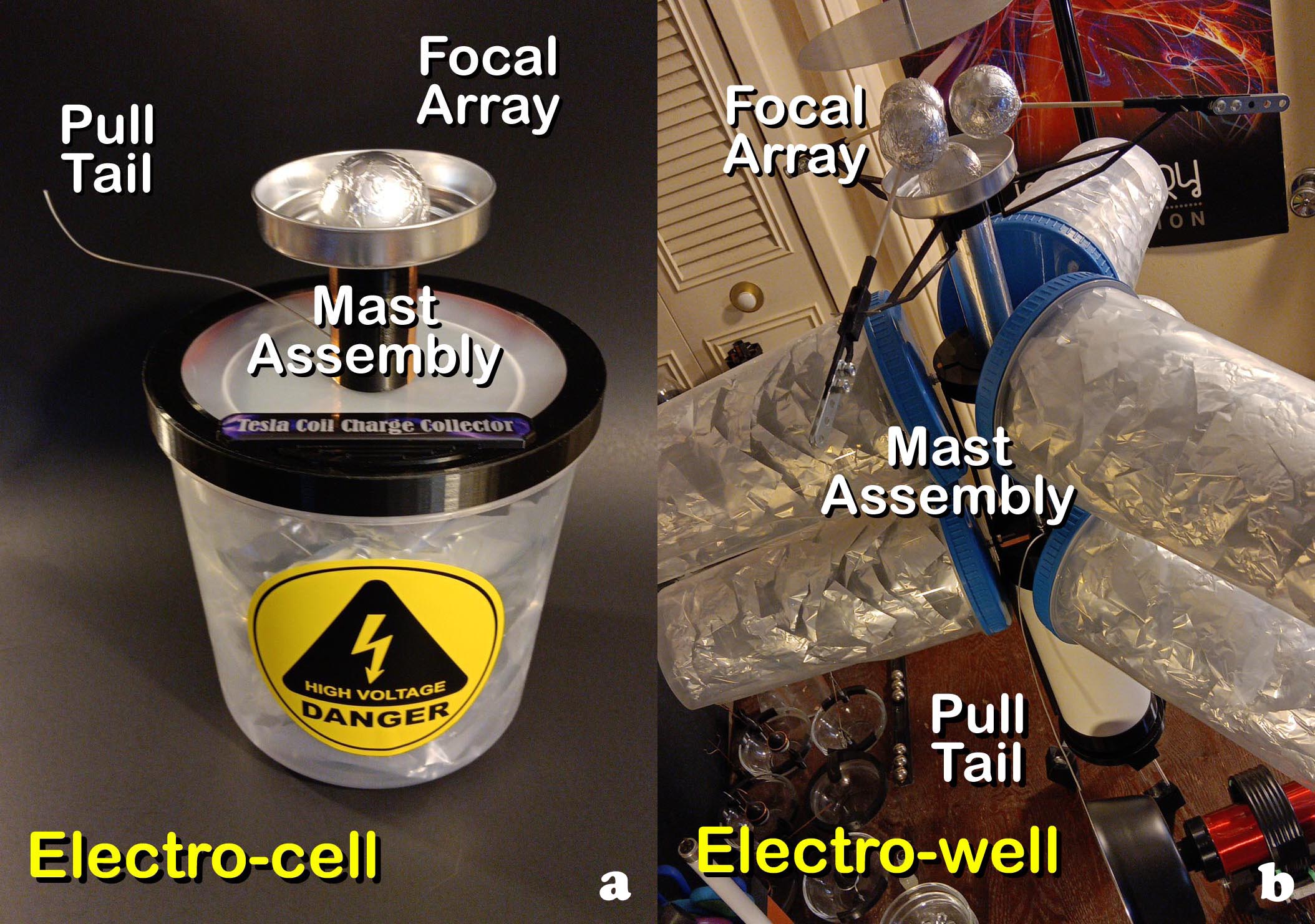
Fig. 1
Mast Assembly:
The mast assembly performs 3 functions; it separates the low, usually opposite / negative field of the cell container and both supports and connects added collector cells along with the main positive "Focal Array" (Fig. 1).
Focal Array:
A focal array consists of smooth, rounded forms (Fig. 2) to keep charges from easily dissipating into atmosphere and shapes or directs an electro-tesla-mechanical induced charge for physical work (Fig. 3).
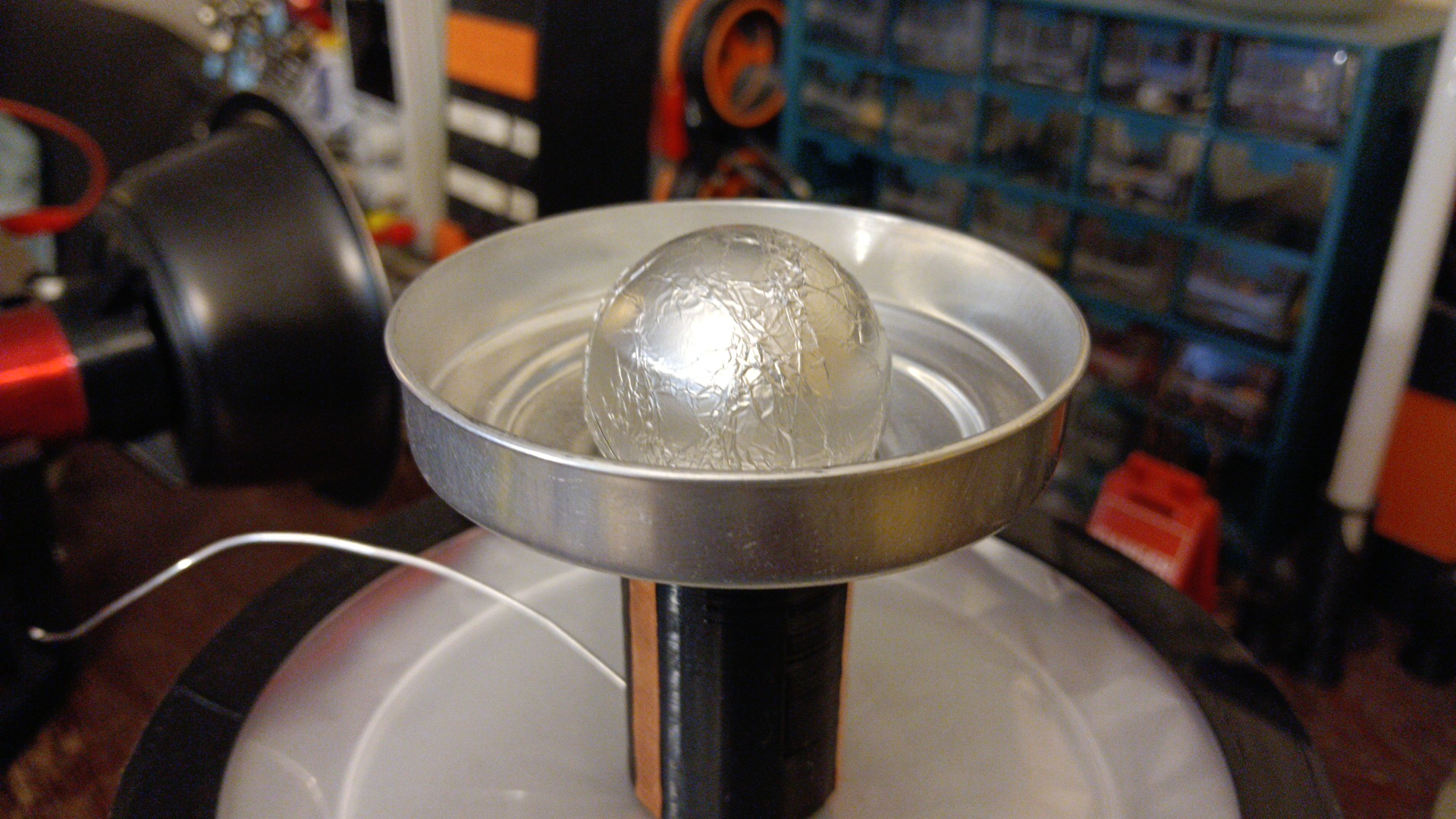
Fig. 2
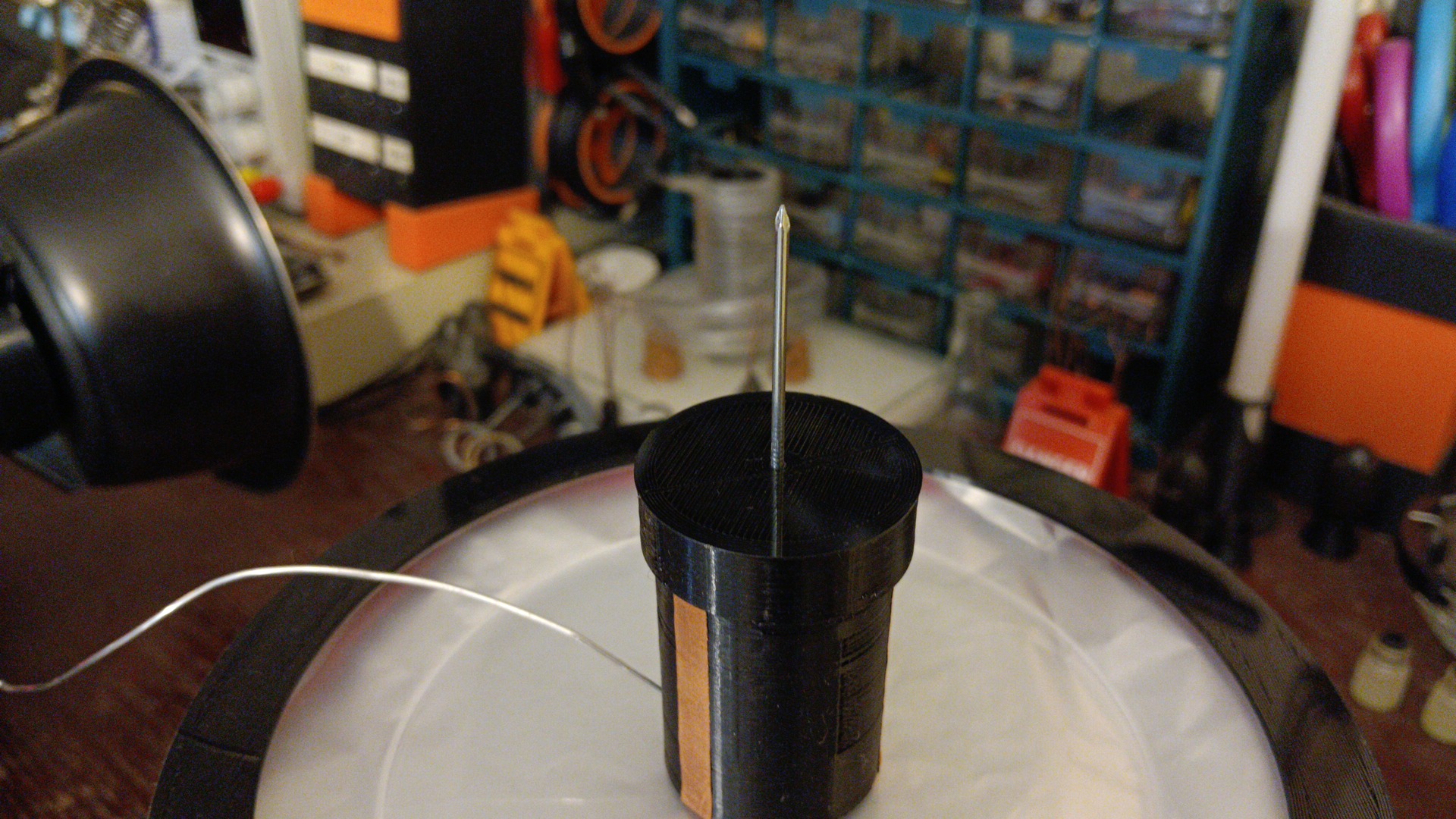 Fig. 3
Fig. 3
The highly-charged field will be strongest at any exposed points and flow over smooth contours. It can be utilized in many ways for pulling or pushing by concentrating the shaped positive field (or inverted to negative, via another added layer of dielectric placed over the focal array) for maximum efficiency or configuring it per intended application of use (Fig. 4, as a spinner).
 Fig. 4
Fig. 4
Pull Tail:
The "Pull Tail" can have many configurations and shapes (Fig. 5) depending on size and power of the overall system, or simply from just the tip of a wire.
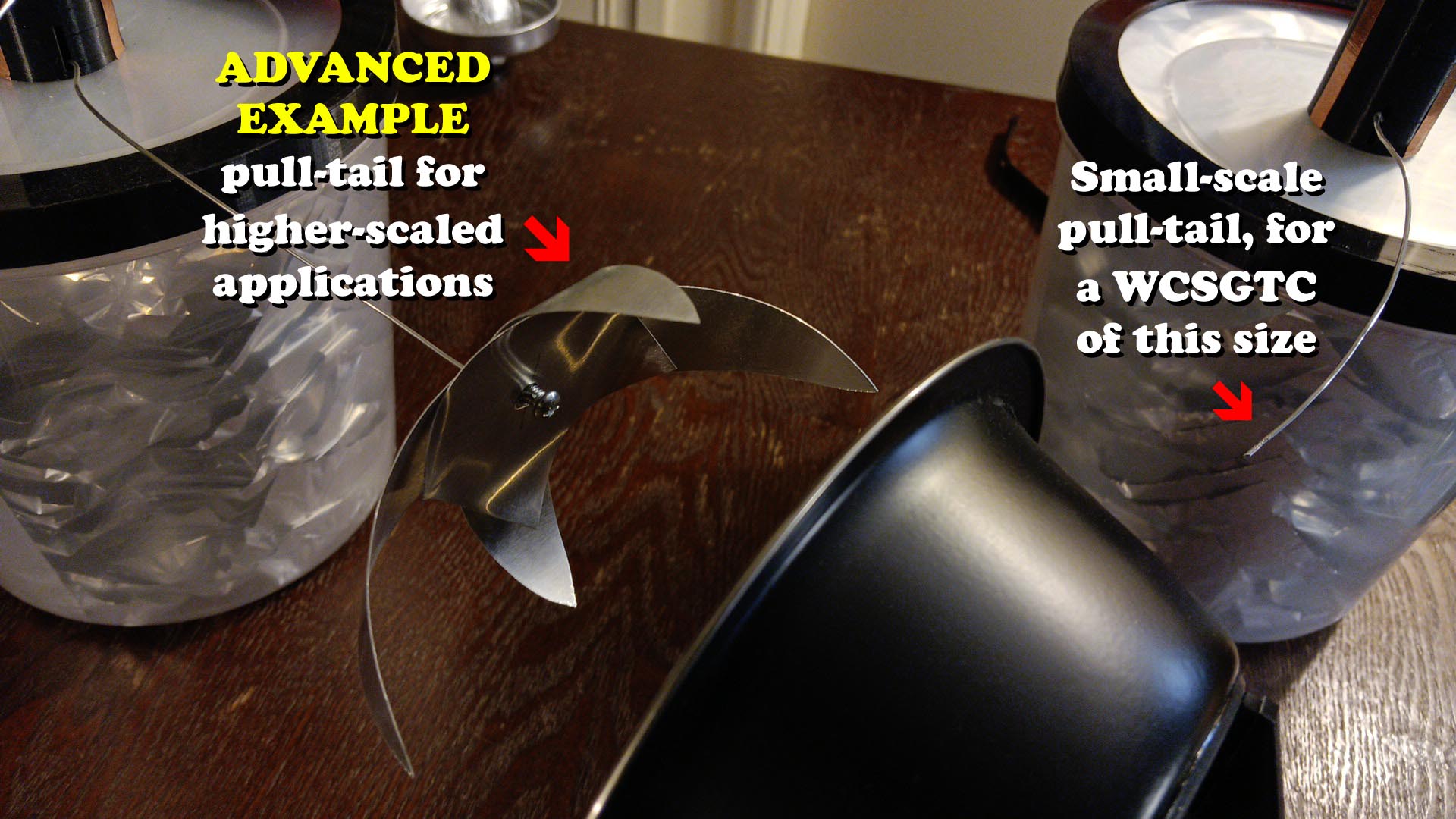 Fig. 5
Fig. 5
The adjustable gap between the "Tesla Coil Collector Dish" and "Pull Tail" function as an EBG Electro-magnetic Buffer Gap (Fig. 6), throttle and means to keep the system's main tesla coil in resonance.
Do not connect this device directly to the tesla coil itself, as it is designed to operate with an air EBG (see diagram below).
*THIS EFFECT CAN ONLY WORK ON THE NEGATIVE SIDE BY 'PULLING' - as pushing a positive flow into the Electro-cell will not charge it properly and can burn or melt holes through the container.
EBG - Electromagnetic Buffer Gap:
An EBG is a required dielectric air gap between the low / ground side of the tesla coil and an Electro-cell collector that initiates the primary effect of conductive charging. The Electro-cell "Pull Tail" is positioned at the concentrated pull points of the "Collector Dish" where its distance of course will need to be increased based on the scale or power being applied.
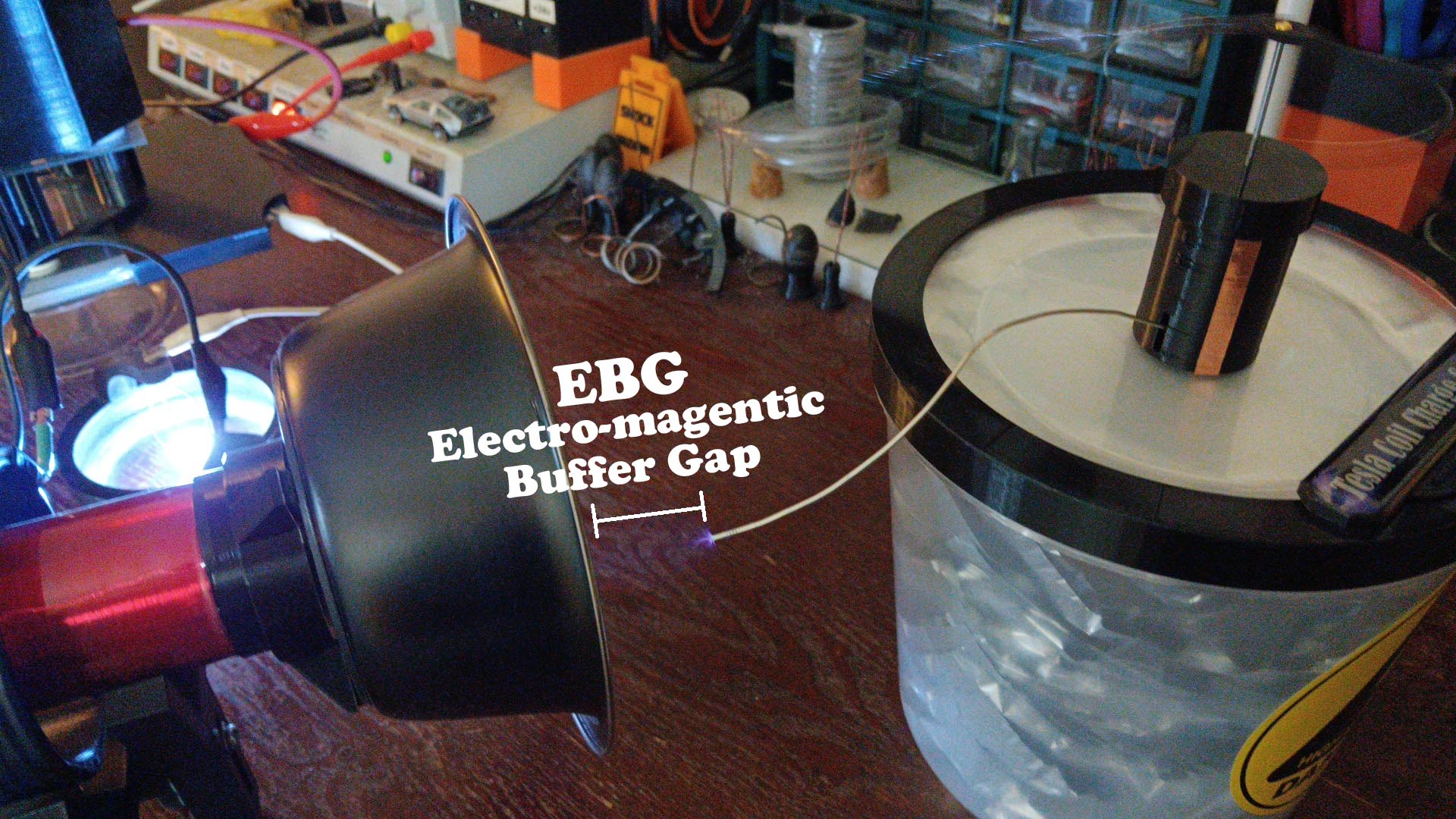 Fig. 6
Fig. 6
SETUP / ADJUSTMENT
Once your WCSGTC is configured, place an Electro-cell's "Pull Tail" at the concentrated field points shown below (Fig. 7), or at any viable point on a metal sphere. The wire can be carefully bent anywhere into position, making sure it doesn't touch the Electro-cell's own rim (Fig. 8).
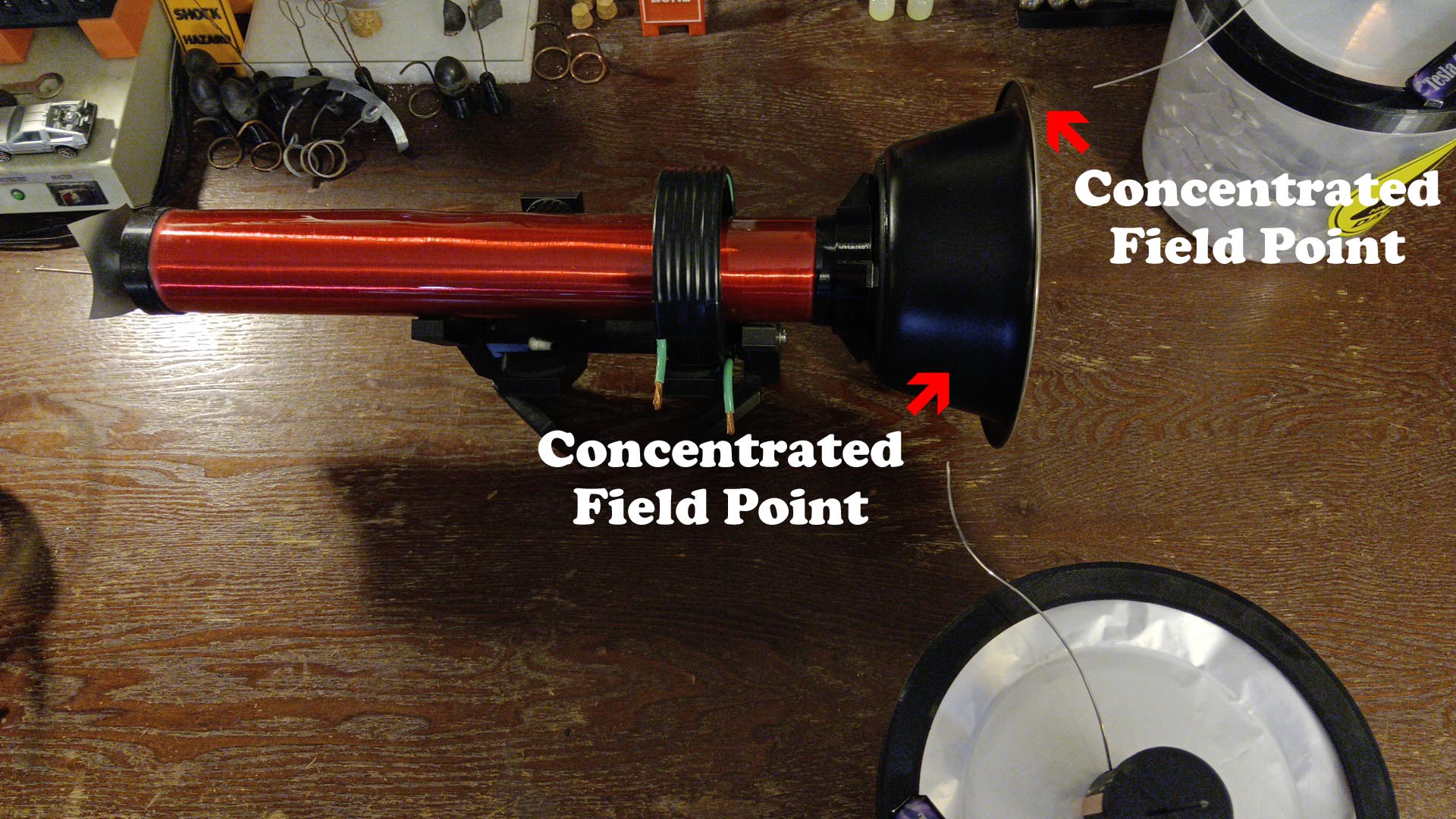 Fig. 7
Fig. 7
 Fig. 8
Fig. 8
Some trial-and-error adjustments towards and away from the concentrated field points will be required by first turning off the system, re-adjusting and then safely re-applying power to check distances.
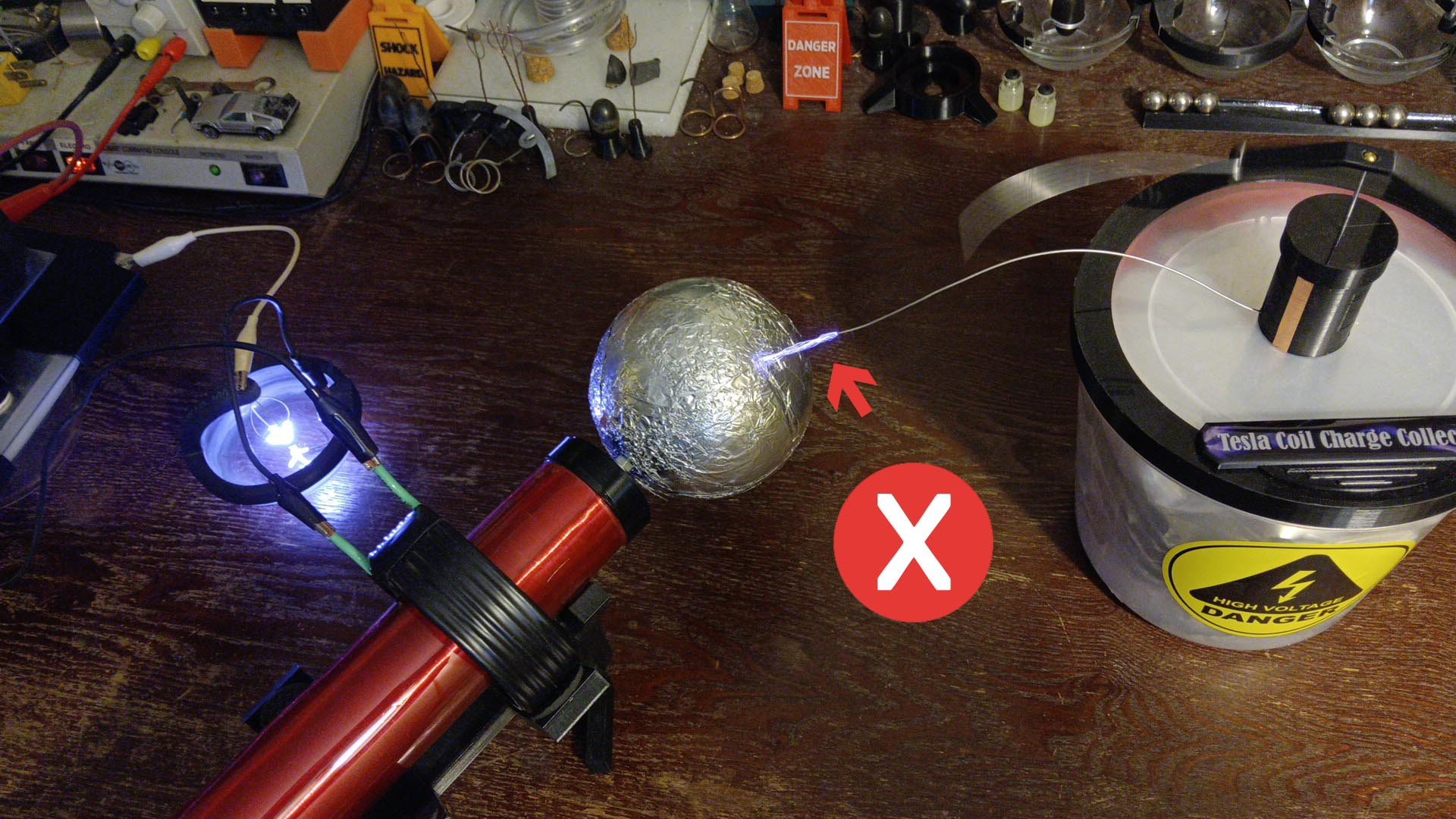 Fig. 9
Fig. 9
Do not let a plasma stream develop (Fig. 9) as this will dramatically reduce available power - although do try experimenting in this state as other 'sporadic / energetic' electro-magnetic effects can be observed when applying a 'plasma EBG' that may have future merit or other possible applications.
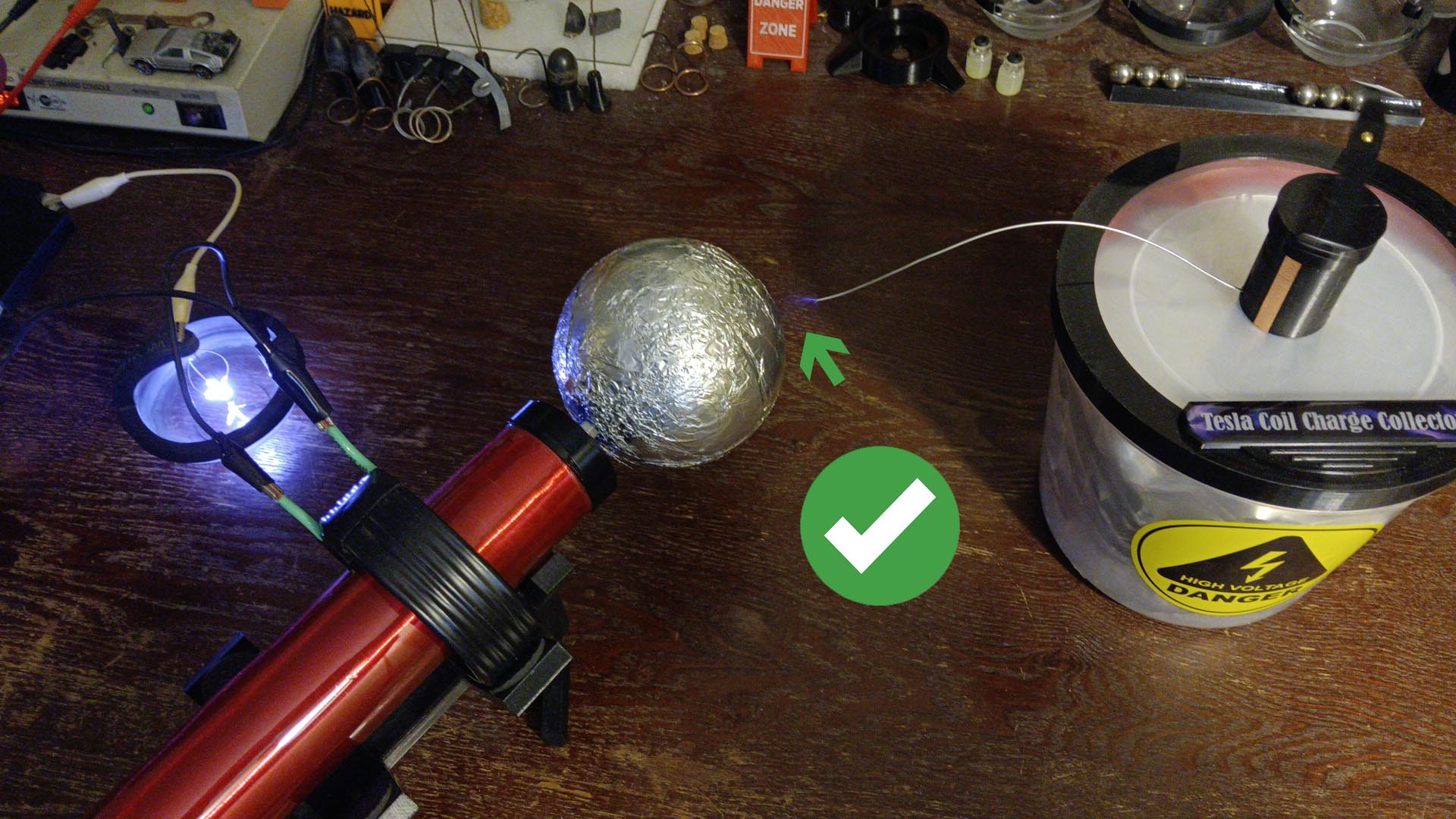 Fig. 10
Fig. 10
A properly positioned "Pull Tail" will have little to no ionization at the tip (Fig. 10, 11) - the "spinner" accessory is a good way to visibly gauge overall field strengths and output power by both the speed and acceleration it exhibits. Remember: never reposition an Electro-cell while the tesla coil is on.
OPERATION
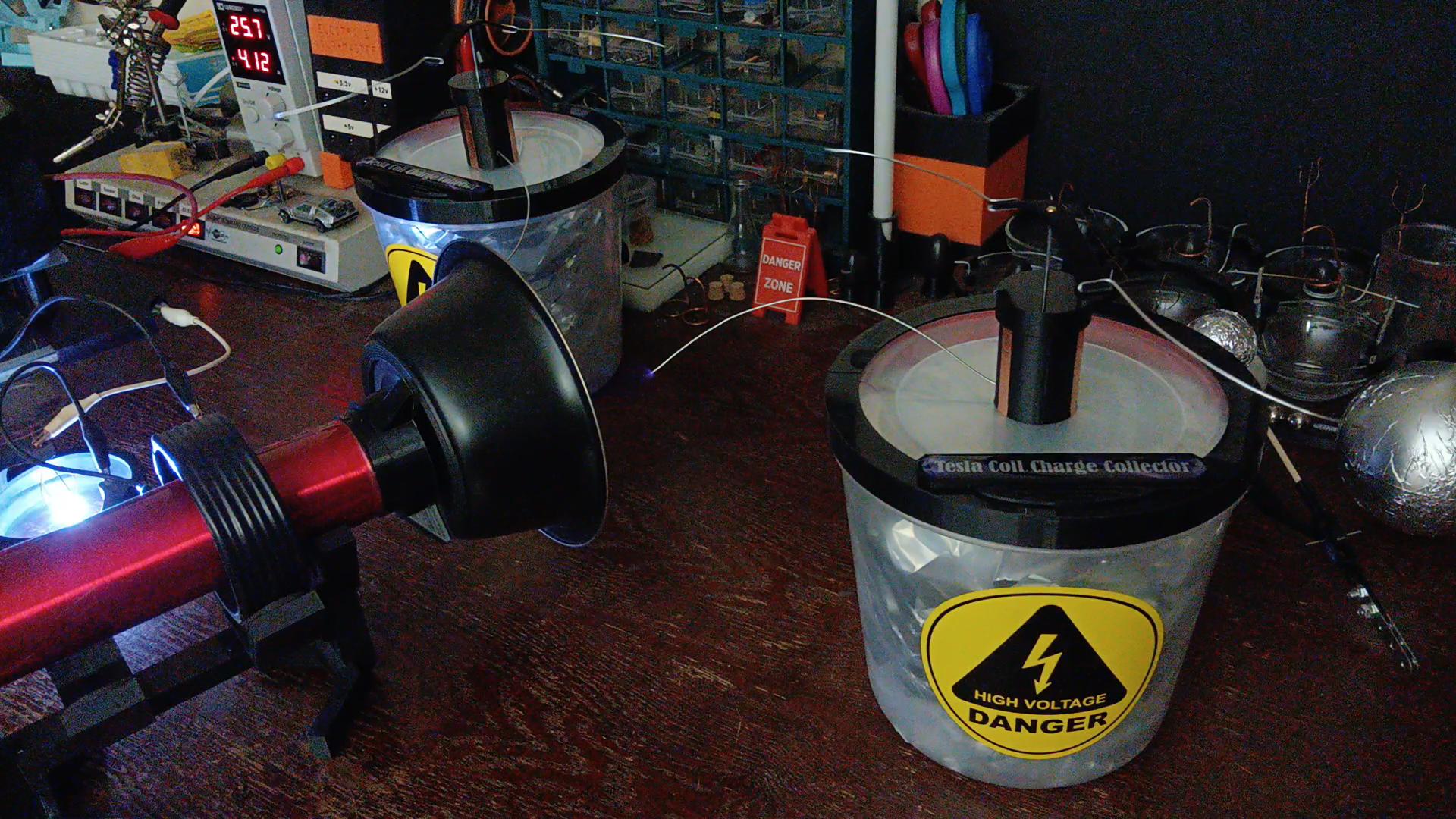 Fig. 11
Fig. 11
The correct setup and application of an Electro-cell (Fig. 11) after using the "spinner" accessory to help initially position and identify field strength locations and gauge overall power.
 Fig. 12
Fig. 12
For maximum effect, you must move as much power through the system as possible. Multiple plasma exit nodes (Fig. 12) improve flow and can act as a means to throttle and build electro-magnetic 'back-pressure' which can additionally be used to control an active Electro-cell's charge and strength levels.
FURTHER NOTES / OBSERVATIONS
• Multiple Electro-cell units can be powered at the same time, however, each must have their own separate 'area / space' for an EBG and the field of the Electro-cell's container itself may interfere as well with accessories like 'spinners', requiring them to be physically spaced far enough apart to function.
• Air moving around the collector shell, "Pull Tail" or "Focal Array" will dissipate charges faster.
• Humidity plays a factor in charge retention and strength level.
• Electro-tesla-mechanical waves / positive charges can be guided along practically any surface or material conductive or not (metal, glass, plastic, wood, string, etc), be sure not to touch - even holding a wooden pole - any part of the WCSGTC system or Electro-cells while they are active.
• Once again, NEVER TOUCH any part of the system WHILE IT IS ON as WCSG's are high-amperage spark gaps and all components attached are extremely dangerous when active.
TROUBLESHOOTING / TIPS
LOW CHARGE - Be sure your WCSGTC has the right (low-rated capacitance) capacitors for moving high-amperage. The higher a rating, the more voltage potential is stored (and must be restored on each spark). Lower rating capacitance will allow more voltage to pass and take less time / energy to restore.
Tip: Check for a melted hole. Also be sure the charge collector is in a dry place (without air moving over it) as humidity and air flow (fans) can reduce strength or quickly dissipate charge to atmosphere.
MELTED HOLE - If you accidentally melt a hole through your collector's shell because of an errant screw or conductive object nearby, it will no longer hold charge. Simply use "hot glue" to fill the hole and seal it.
Tip: Always be sure the area around your charge collector is clear of debris and use the provided glass isolation plate to further ensure stronger charges / safe operation.
INCREASE PHYSICAL ACTION - You can easily increase the amount of pull and push your Electro-cell physically has on an object by introducing an opposing ground field that will create a more powerful effect during and after the system has charged.
Tip: Use the provided "Ground wire stand" to position and shape a ground field near an object, or place the object in-between it and the "Focal Array", to maximize physical reactions and effects.
